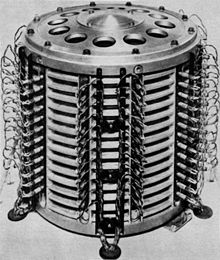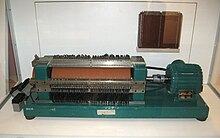Drum memory
Drum memory was a magnetic data storage device invented by Gustav Tauschek in 1932 in Austria.In most designs, one or more rows of fixed read-write heads ran along the long axis of the drum, one for each track.In November 1953 Hagen published a paper disclosing "air floating" of magnetic heads in an experimental sheet metal drum.This method of timing-compensation, called the "skip factor" or "interleaving", was used for many years in storage memory controllers.Magnetic drum memory units were used in the Minuteman ICBM launch control centers from the beginning in the early 1960s until the REACT upgrades in the mid-1990s.

drum machineComputer memorydata storageMemory cellMemory coherenceCache coherenceMemory hierarchyMemory access patternMemory mapMOS memoryfloating-gateContinuous availabilityAreal density (computer storage)Block (data storage)Object storageDirect-attached storageNetwork-attached storageStorage area networkBlock-level storageSingle-instance storageStructured dataUnstructured dataBig dataMetadataData compressionData corruptionData cleansingData degradationData integrityData securityData validationData validation and reconciliationData recoveryStorageData clusterDirectoryShared resourceFile sharingFile systemClustered file systemDistributed file system for cloudDistributed data storeDistributed databaseDatabaseData bankData storeData deduplicationData structureData redundancyReplication (computing)Memory refreshStorage recordInformation repositoryKnowledge baseComputer fileObject fileFile deletionFile copyingBackupCore dumpHex dumpData communicationInformation transferTemporary fileCopy protectionDigital rights managementVolume (computing)Boot sectorMaster boot recordVolume boot recordDisk arrayDisk imageDisk mirroringDisk aggregationDisk partitioningMemory segmentationLocality of referenceLogical diskStorage virtualizationVirtual memoryMemory-mapped fileSoftware entropySoftware rotIn-memory databaseIn-memory processingPersistence (computer science)Persistent data structureNon-RAID drive architecturesMemory pagingBank switchingGrid computingCloud computingCloud storageFog computingEdge computingDew computingAmdahl's lawMoore's lawVolatileCPU cacheScratchpad memoryQDRSRAMXDR DRAM1T-SRAMContent-addressable memoryComputational RAMDual-ported RAMVideo RAM (dual-ported DRAM)Williams–Kilburn tubeDelay-line memoryMellon optical memorySelectron tubeDekatronNon-volatileDiode matrixEEPROMROM cartridgeSolid-state storageFlash memorySolid-state driveSolid-state hybrid driveUSB flash driveIBM FlashSystemFlash Core ModuleMemory cardMemory Stick